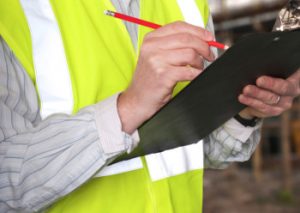Employers
 Employers need to understand the extent of their management or control. For example, if you lease or rent your premises – then you should check your leasing agreement to establish to what extent you may have management or control.
Employers need to understand the extent of their management or control. For example, if you lease or rent your premises – then you should check your leasing agreement to establish to what extent you may have management or control.
Employers are responsible for additional legal duties in their capacity as an employer in relation to managing asbestos. For example, employers may have a duty to consult under the Occupational Health and Safety Act 2004 in relation to managing and removing asbestos in their workplace.
Information about your legal duties in relation to managing and removing asbestos is provided below.

Self-employed

When dealing with asbestos self-employed persons (and employers) must eliminate, so far as reasonably practicable, the exposure of persons at the workplace to asbestos fibres arising from the work they are undertaking. If it is not reasonably practicable to eliminate that exposure, you must ensure that you reduce the exposure so far as is reasonably practicable.
Generally a self-employed person must also meet the same requirements as employers with regard to:
- Removal of asbestos from a workplace
- Removal of contaminated clothing
- Use of certain tools or instruments
- Disposal of asbestos waste
Further specific requirements apply when:
1. Under the Occupational Health and Safety Act 2004, self-employed person(s) in general have similar duties to employers. For further information on employer duties go to the Employer section.
2. A self-employed person is typically a builder or tradesperson. The Builders and Trades section has asbestos information specific to whether you are working at a domestic or commercial premises, and specific to refurbishment or demolition work.
Commercial property owners
(Person with management or control)
 If you are a commercial property owner who leases or rents, for example, a building or part of a building to a business or businesses, then you may have obligations under the Occupational Health and Safety Act 2004 and the Occupational Health and Safety Regulations 2007 to the extent of your management or control.
If you are a commercial property owner who leases or rents, for example, a building or part of a building to a business or businesses, then you may have obligations under the Occupational Health and Safety Act 2004 and the Occupational Health and Safety Regulations 2007 to the extent of your management or control.
A commercial property leased or rented to businesses (i.e. employers) is regarded as a workplace under Victoria’s health and safety laws.
If you engage a property manager, then the responsibility of managing asbestos may be delegated to the property manager. However, legal duties in relation to health and safety (including managing asbestos) cannot be delegated and you, as the owner, are ultimately responsible for ensuring such workplaces are safe and without risks to health so far as is reasonably practicable. You should therefore ensure the property owner is competent in performing their role, which may include the need to manage asbestos.
The sections below provide detailed information about your responsibilities for managing asbestos:
-
- Find and identify
- Manage
- Licensed asbestos removalist
Find and identify
As a commercial property owner of premises leased or rented to business, you may have management or control of your premises.
Use this checklist to help you find and identify asbestos in your building or structure.
-
- Identify when the building was constructed
Asbestos was widely used as a construction and insulation material in buildings constructed before the late-1980s. Australia banned the use or import of blue and brown asbestos or asbestos products in the mid-1980s, and banned all manufacture or import of white asbestos products in December 2003.
However, building materials may have been stockpiled, stored or recycled and used in the construction of buildings after the bans came into place. This means there is still a chance that asbestos containing materials may be in buildings constructed after the mid-1980s.
Of course any refurbishment or extensions to an original building before the mid-1980s may have used asbestos containing materials. Just because the original parts of the building do not contain asbestos, you should not assume that additions do not.
- Identify what materials were used in constructing the building
Think about your building’s main construction materials. Is it constructed from timber, brick, steel, cement sheet or another material?
If you have cement sheet, there’s a chance it could contain asbestos fibres bonded to cement particles. For example, if a roof is made from corrugated cement sheeting, there’s a chance it contains asbestos.
Because of the hardiness and waterproofing qualities of asbestos, areas of the building prone to wet conditions like bathrooms, toilets and laundries may have asbestos sheeting or asbestos vinyl tiles in the walls and floors. Likewise, pipes throughout the building that carry water and sewage may also contain asbestos.
- Do a walkthrough inspection to find asbestos
Conduct a thorough inspection of all buildings and structures including all rooms and spaces, ceiling spaces, cellars, shafts, storage areas and wall cavities.
You should always assume material contains asbestos, or get it tested when:
– it can’t be identified
– it can’t be accessed and is likely to contain asbestos
– you otherwise can’t be sure it doesn’t contain asbestos.
The design plans for a building, structure, ship or plant may help in identifying inaccessible areas. Talking to builders, architects, manufacturers of plant and maintenance employees can also help. Experience and findings from inspections of similar sections of the building (or similar buildings) may also be helpful.
It’s important to take notes and photos during your inspection because the notes can be used to produce the asbestos register.You can find more information about asbestos registers in the Manage Asbestos section
- Use a competent person to identify asbestos
Anyone inspecting for asbestos, determining risk, or recommending control measures must be competent to do so.
To be competent a person should:
– have appropriate training, knowledge and experience in identifying suspected asbestos materials and be able to determine risk and appropriate controls
– be familiar with building and construction practices to determine where asbestos is likely to be present
– be able to determine that material may be friable or non-friable and evaluate its condition.
If you do not have the capability to identify asbestos, then you should use an external providers, for example, a consultant.
- Selecting an external provider
When selecting an external provider, you should consider:
– their background and experience
– their specific expertise
– their qualifications or professional affiliations
– references from previous work (consider asking for examples of reports prepared for other clients).
An example of a suitably competent person may be an occupational hygienist with experience in identifying asbestos and assessing its associated risks.
An occupational hygienist who specialises in asbestos can provide advice on:
– identifying asbestos in a workplace
– developing an asbestos register
– reviewing an asbestos register
– the sampling of asbestos fibres in the air and the comparison of these to the asbestos exposure standard
– provision of a clearance certificate
How to find an Occupational Hygienist
You can find a qualified Occupational Hygienist through the Australian Institute of Occupational HygienistsThis external link will open in a new window.National Association of Testing Authority
A suitably competent person may also be found at companies approved by the National Association of Testing AuthoritiesThis external link will open in a new window (NATA) - Taking samples of asbestos
If samples are taken for the purpose of determining if asbestos is present, it is important that representative samples are taken. If there are variations in appearance, texture or colour of the material you’ll need to take additional samples for consistency and valid analysis. For example, full-thickness samples of friable material back to the substrate should be taken. You should also consider taking samples from difficult areas where there is evidence of previous asbestos removals.
The analysis must be undertaken [insert the Asbestos Samples] by a person who is suitably trained and experienced in a safe method of taking samples of asbestos-containing materials.
Samples should be taken in a controlled manner that does not create a risk to the person taking the sample, or people who will work or visit the area where the sample was taken. People taking samples should assess the risk and implement appropriate controls. These may include the use of a high-efficiency particulate air (HEPA) filtered vacuum cleaner and/or a water spray bottle to suppress airborne dust (a respirator – approved by AS/NZS 1716:2003 Respiratory protective devices – may also be used to minimise exposure).
Samples need to be placed in sealed containers (for example, snap-lock durable bags) and appropriately labelled so that it’s clear where the sample was taken.
Find out more about taking asbestos samples
- Arrange for analysis of asbestos samples
Under the Occupational Health and Safety Regulations 2007, only approved analysts can analyse samples containing asbestos.
An approved asbestos analyst is an analyst approved by NATA to perform asbestos fibre counting or to identify asbestos in samples and to issue findings as endorsed reports under the authority of a NATA-accredited laboratory.
Before you take a sample to a laboratory, you should confirm the laboratory is accredited to perform asbestos analysis. You can do this by visiting National Association of Testing AuthoritiesThis external link will open in a new window (NATA).
The laboratory will give you a report of your asbestos sample. Endorsed reports have the NATA insignia stamped on the report. You should keep the endorsed report as evidence of compliance.
Manage
As a commercial property owner of premises leased or rented to business, if you identify asbestos-containing material then you are responsible for managing the asbestos (including plant) that is under your management or control, so far as is reasonably practicable. This includes ensuring all asbestos and suspected asbestos is documented in your asbestos register.
If the asbestos is in good condition and left undisturbed, it is usually safer to leave it fixed or installed and review its condition over time provided it is unlikely that asbestos fibres will be released into the air and the risk to health is extremely low. The presence and location of identified asbestos must be clearly indicated, and if reasonably practicable, the indication is by labelling. If the asbestos has deteriorated, ie: asbestos dust is present and therefore it is likely that airborne asbestos fibres may be released into the air, then you must control the risk by, for example, removing the asbestos
There are a number of steps you can take to help you manage and control asbestos in your workplace, including controlling the risk, notifying anyone contracted to work at the workplace of the presence of asbestos, managing your asbestos register and informing all employers in the immediate and adjacent areas of any proposed asbestos removal work.
Following the steps below can help you manage and control asbestos in your building or structure
- Create an asbestos register
Whenever asbestos is identified in a workplace, you need to create an asbestos register to record the presence of all asbestos in the workplace. Asbestos registers must be reviewed if there is a change to the condition of asbestos, including if it is removed, enclosed or sealed. The register must also be reviewed and if necessary revised every five years to keep it current.
- Provide access to the asbestos register
You must provide a copy of your asbestos register:
– Any employer or self-employed person whose business is located at the workplace
– An asbestos licence-holder who has been engaged to do asbestos removal work
– Other persons, including those who perform the follow asbestos-related activities:– Sampling or analysing suspected asbestos
– Enclosing or sealing asbestos
– Hand-drilling or cutting asbestos
– Conducting research involving asbestos
– Performing any other work activity likely to produce asbestos airborne fibres in excess of one half of the asbestos exposure standard.– Anyone who takes over management or control of the workplace.
– Any employer or self-employed person who proposes to occupy the workplace (if requested) - Inform contractors who enter the workplace
Before they start, any contractors who are engaged to perform work that involves the risk of exposure to asbestos must be provided with access to the asbestos register. The register must include the location of the asbestos.
A permit-to-work system can be implemented to ensure contractors are aware of asbestos before starting work.
- Control the risk
The Occupational Health and Safety Regulations specify three stages in the hierarchy of controls that must be used to control risks from asbestos.
1. Eliminate the risk so far as reasonably practicable by removing the asbestos
2. If a risk remains, reduce the risk so far as reasonably practicable by enclosing the asbestos
3. If a risk remains, further reduce the risk so far as reasonably practicable by sealing the asbestos.
Remove and dispose
As a commercial property owner of premises leased or rented to business, if you decide to have asbestos removed from your premises (including plant or equipment), then you are responsible for ensuring the removal is carried out safely. Although unlicensed removal of limited amounts of non-friable asbestos is permitted, it is not recommended as it may be safer for a Licensed Asbestos Removalist to perform the asbestos removal.
If you need to engage a Licensed Asbestos Removalist to remove asbestos from your workplace, the steps below can help you manage the process.- Find a Licensed Asbestos Removalist
You can use the Find a Licensed Asbestos Removalist tool to locate a licensed removalist in your area
There are two types of licenses for asbestos removal – Class A and Class B. Only Class A license-holders can remove friable asbestos. Read examples of when it’s a Class A or B licensed removalist that is needed.
- Notify tenants about the asbestos removal
You should work closely with any employers or self-employed persons who lease your premises so that they are aware of the asbestos removal that is due to take place. They have a responsibility to protect the health and safety of their employees, so they will need to be aware of the situation and take necessary precautions.
- Get a clearance certificate
If you commission the asbestos removal work, you must obtain a clearance certificate. The clearance certificate must be obtained from an independent person before the areas where the asbestos removal work was being performed can be re-occupied. An independent person is someone who is independent from you and the licensed asbestos removalist.
A clearance certificate is a written statement confirming that the area has been cleaned satisfactorily and is safe to be re-occupied for normal use. You will need a clearance certificate if the removal work involved any quantity of friable asbestos, or if it involved more than 10 square metres of non-friable asbestos.
If you hired an asbestos consultant to manage the process, they can act as the independent person and can issue the clearance certificate. If you did not hire a consultant, an independent competent person with sufficient knowledge, skills and experience can issue the clearance certificate.
You can find a qualified Occupational Hygienist through the Australian Institute of Occupational Hygienists This external link will open in a new window.
- Update the asbestos register
When asbestos is removed from your workplace, you must update your asbestos register to reflect the removal of asbestos. You must also update the asbestos register in circumstances where asbestos has been sealed or enclosed.
Employees
What I need to know.
Your employer has a legal duty to eliminate or reduce so far as is reasonably practicable the risk to anyone in their workplace of exposure to airborne asbestos fibres.
If any part of your work includes the possibility of coming into contact with asbestos, your employer must provide you with necessary:
- information
- instruction
- training
- supervision
to enable you to perform your work in a way that is safe and without risk to health. This includes making the asbestos register readily accessible to employees and being required to advise employees of any proposed asbestos removal work.
If any part of your work is in area has asbestos which could be disturbed your employer should conduct risk assessments and implement controls to control the risk of exposure so far as is reasonably practicable.
At the same time, you have a general duty to:
- take reasonable care for your own health and safety and that of others who may be affected by your work
- cooperate with your employer’s efforts to make the workplace safe.
This may include:
- following workplace policies and procedures
- using equipment correctly
- attending health and safety training
- helping to identify hazards and implementing risk control measures
Your employer must consult you and your fellow employees through your health and safety representative, or where one does not exist, directly, on any health and safety issues including asbestos, where it directly affects you.
If you are concerned about an asbestos issue in your workplace, you should talk to your employer or Health and Safety Representative. If you still have concerns after speaking to your employer or Health and Safety Representative, you can contact the Work Safe Advisory Service on 1800 136 089.
Laws and guidance
 There are a number of laws, compliance codes and guidance documents that can help you understand your obligations relating to asbestos.
There are a number of laws, compliance codes and guidance documents that can help you understand your obligations relating to asbestos.The Occupational Health and Safety Act 2004 and the Occupational Health and Safety Regulations 2007.
Work Safe issues Compliance Codes to provide practical guidance to those who have duties or obligations under the OHS Act and regulations. For asbestos the:
- Managing Asbestos in Workplaces Compliance Code provides information on how you can safely manage asbestos in your workplace, and the
- Removing Asbestos in Workplaces Compliance provides information on how you can arrange for the safe removal of asbestos from your workplace.
A Dangerous Goods Order relating to asbestos was issued on 28 June 2007. This order prohibits the removal of asbestos that is not fixed to or installed in a building, structure, ship or plant at any workplace, except under certain circumstances.
Work Safe has also issued a number of asbestos related publications and guidance materials.
- Find a Licensed Asbestos Removalist
- Create an asbestos register
- Identify when the building was constructed
